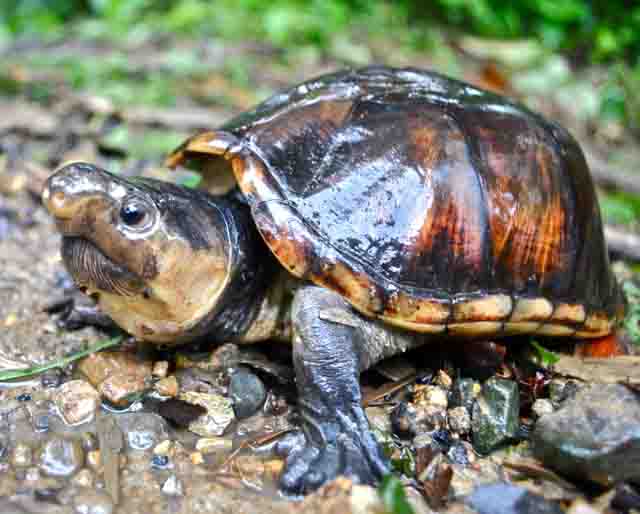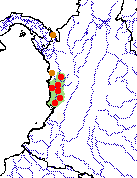Kinosternon dunni, 067
Kinosternon dunni Schmidt 1947 –
Dunn’s Mud Turtle, Cabeza de Trozo
John B. Iverson1, John L. Carr2, Olga V. Castaño-Mora3,
Carlos A. Galvis-Rizo4, Luis E. Rentería-Moreno5, and Germán Forero-Medina6
1Department of Biology, Earlham College, Richmond, Indiana 47374 USA [[email protected]];
2Department of Biology, The University of Louisiana at Monroe, Monroe, Louisiana 71209 USA,
and Universidad del Valle, Facultad de Ciencias, Departamento de Biología, Sección de Zoología,
Grupo de Investigación en Ecología Animal, A.A. 25360, Cali, Colombia [[email protected]];
3Instituto de Ciencias Naturales, Universidad Nacional de Colombia, Bogotá, Colombia [[email protected]];
4Fundación Zoológica de Cali, Cali, Colombia [[email protected]];
5Universidad Tecnológica del Choco, Quibdó, Colombia [[email protected]];
6Wildlife Conservation Society and Turtle Survival Alliance,
Carrera 25#4-39, Cali, Colombia [[email protected]]
Summary. – Dunn’s Mud Turtle, Kinosternon dunni (Family Kinosternidae), is a medium-sized aquatic turtle (carapace length to at least 180 mm) found in streams and marshes in the Río Baudó, Río Docampadó, Río San Juan, and Río Atrato drainage basins of the Departamento del Chocó in western Colombia. It is most similar and closely related to K. angustipons from Central America, and belongs to the K. leucostomum species group. Very little is known of the natural history of this species. It is apparently carnivorous and probably highly aquatic. It may reproduce nearly year-round, laying multiple clutches of one or two eggs each. A field survey of each of the four inhabited basins is urgently needed to assess the population status of this species. Because of its restricted range and apparent rarity, and because it is eaten locally, it could be more threatened than currently recognized.
Distribution. – Colombia. Apparently confined to the the Departamento del Chocó in the Chocoan rainforest area in the Pacific coastal drainages of the Ríos Baudó, Docampadó, San Juan, and the Caribbean-drained upper Río Atrato in western Colombia.
Synonymy. – Kinosternon dunni Schmidt 1947.
Subspecies. – No subspecies have been described.
Status. – IUCN 2012 Red List Status: Vulnerable (VU B1+2c; assessed 1996, needs updating); TFTSG Draft Red List: Vulnerable; CITES: Not Listed; Colombian Red Data Book: Vulnerable.
Citation:
Iverson, J.B., Carr, J.L., Castaño-Mora, O.V., Galvis-Rizo, C.A., Rentería-Moreno, L.E., and Forero-Medina, G. 2012. Kinosternon dunni Schmidt 1947 – Dunn’s Mud Turtle, Cabeza de Trozo. In: Rhodin, A.G.J., Pritchard, P.C.H., van Dijk, P.P., Saumure, R.A., Buhlmann, K.A., Iverson, J.B., and Mittermeier, R.A. (Eds.). Conservation Biology of Freshwater Turtles and Tortoises: A Compilation Project of the IUCN/SSC Tortoise and Freshwater Turtle Specialist Group. Chelonian Research Monographs No. 5, pp. 067.1–067.5, doi:10.3854/crm.5.067.dunni.v1.2012, //iucn-tftsg.org/cbftt/.
(Adobe Acrobat 6.0 or later required)

Adult male Kinosternon dunni from the southern Río Atrato, Chocó, Colombia.
Photo by Germán Forero-Medina.
Distribution:

Distribution of Kinosternon dunni in Colombia in northwestern South America. Red dots = museum and literature occurrence records of native populations based on Iverson (1992), plus more recent and authors’ data; brown dots = possible occurrence records; green shading = projected native distribution based on GIS-defined hydrologic unit compartments (HUCs) constructed around verified localities and then adding HUCs that connect known point localities in the same watershed or physiographic region, and similar habitats and elevations as verified HUCs (Buhlmann et al. 2009), and adjusted based on authors’ data.








